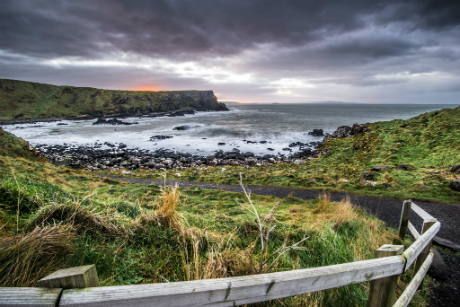Commercial Insights

No area reflects the complexity of Brexit better than Northern Ireland’s border with the Republic of Ireland. It represents the UK’s only land border with the European Union, and thus a unique Brexit battleground with many legal and economic challenges to consider.
The Irish border is 499 km long. It compromises 40 border towns and approximately 300 formal border crossings, with many more informal ones. Around 1,851,000 cars cross the line per month. Every year, 400,000 lambs and over 800 million litres of milk are exported to the Republic from Northern Ireland, with 400,000 pigs travelling the opposite way. In 2016, £5.3 billion worth of goods and services were exchanged over the border. In the course of just one day, over 20,000 people commute across it.
Over two years after the Leave Campaign won on June 23, 2016, the outlook of Brexit seems more uncertain than ever. On July 8, 2018, David Davis resigned from his office as secretary of state for exiting the European Union, followed by Boris Johnson resigning from his post as foreign secretary the next day and a swift cabinet reshuffle.
Theresa May spoke on July 20 in Belfast after releasing a 98-page white paper on her plans for Brexit. As it stands, May pledges to fight a hard border between Northern Ireland and Ireland. Calling for the EU to respond and evolve their position, she said, “Early in this process, both sides agreed a clear desire to find solutions to the unique circumstances in Northern Ireland, through a close future relationship.” However, exactly how Britain will navigate the question of the Irish border post-Brexit remains unclear.
The origins of the border go all the way back in the Irish Constitution of 1937, which didn’t recognise the line between Northern Ireland and Ireland as a constitutional fact, though it did acknowledge it as a working reality. Most relevant, Article 2 stated “the national territory consists of the whole island of Ireland, its islands and the territorial seas”, while Article 3 referred to the future “reintegration of the national territory”.
The significance of the constitutional nature of the border is perhaps overtaken by many legal and political agreements, such as the Common Travel Area (CTA). Within this area, both Irish and British citizens can move freely. This has occurred to various degrees since the partition of Ireland. Other features of the border include Irish citizens’ unique status in UK law relating to voting rights, and the free movement of capital, goods and services.

The Giant's Causeway, Northern Ireland. Image credit: Giuseppe Milo.
The lasting impact of the Good Friday Agreement can be seen in the Consent principle, where it’s accepted that Northern Ireland is part of the UK, but will form a part of a united Ireland “brought about only by peaceful means with the consent of a majority of the people, democratically expressed, in both jurisdictions in the island”, according to Section 1 of the Northern Ireland Act 1998 and the amended Article 3 of the Irish Constitution. It is this principle which complicates things for both Northern Ireland and Ireland in the light of Brexit and takes issue on the border between them.
The EU, Irish institutions and UK governments agree that there’s a shared concern to avoid legal, political and economic difficulties for Ireland due to Brexit. The border, in particular, is a point of contention, with Northern Ireland’s first and deputy first ministers stating their view that the border shouldn’t be allowed to develop into an impediment on the island, for example by becoming a catalyst for illegal activities. No one has forgotten the enforced border controls required during the Troubles between the early 1970s and the late 1990s.
A study by the European Parliament condensed what is perhaps the core issue of the Irish border issue: “Brexit will mean that the UK will no longer have an obligation under EU law to carry out the Good Friday Agreement, and EU law principles will no longer protect rights given under the Agreement, in particular the rights under the Charter of Fundamental Rights, the right to have legislation inconsistent with EU law set aside, and the right to compensation for loss caused by breach of EU law.”
The intersection between EU law, the Irish Constitution and the Good Friday Agreement clashes post-Brexit, with many legal complications to consider. As existing EU rules on matters such as police and judicial cooperation, justice and home affairs will no longer apply in the UK after Brexit, they will need to be replaced by agreements between the EU and the UK, bilateral Ireland-UK agreements, or both. How this is arranged has particular importance due to organised crime in Northern Ireland and free movement within the CTA.
The NSMC (North/South Ministerial Council) provides another sticking point. Established under the Good Friday Agreement to develop consultation, co-operation and action within the island of Ireland, the NSMC works in areas of “mutual interest” such as Water-ways Ireland; Food Safety Promotion Board; Trade and Business Development Body; Special European Union Programmes Body; the Language Body; and the Foyle, Carlingford and Irish Lights Commission. After Brexit, the NSMC will still be able to discuss matters arising from EU law, but crucially Northern Ireland Ministers will not be formally bound by it. Therefore, it can be expected that Brexit will dilute at least some aspects of North/South co-operation.
“While I think it will be fine in terms of free movement, I’m more worried about where I’m getting my food from and how it’s getting taxed.”
On top of the legal minefield are the worrying economic implications. The European Parliament has stated: “The adverse effects of Brexit will be greater for Ireland than for any other EU Member State. There will be substantial job losses. Brexit will upset the existing economic links between the Republic of Ireland and the UK, and in the longer term will lead to less trade between them.”
If Britain decides to add VAT at its borders to EU goods (the same as we do with non-EU goods), huge amounts of new infrastructure will be required. Irish Taoiseach Leo Varadkar has said that Ireland is already looking to hire 1,000 officials for customs, veterinary and export checks to cope in the case of no agreement.
But it’s not just the Republic that will suffer. The Confederation of British Industry blamed uncertainty over Brexit as the reason economic data showed Northern Ireland to be edging towards recessionary territory. For businesses on both sides of the border, the economic effects are worrying. Irish and EU leaders warn that there isn’t much time left to solve it.
Without a Brexit deal, Ireland could be forced into what Joachim Pfeiffer (a key ally of Angela Merkel) is calling the “hardest border in Europe”. Some people are worried, with one London-based woman from Cork saying, “The implications for all of my generation who left due to the recession but want to return eventually is in jeopardy, and our little country feels like a scapegoat for Brexit not going in the UK’s favour.” Another man, from Drogheda, County Louth, was less concerned, saying, “While I think it will be fine in terms of free movement, I’m more worried about where I’m getting my food from and how it’s getting taxed.”
At the moment, there’s no obvious answer to the Irish border issue, despite calls to avoid a hard border on both sides. The European Council’s request for “flexible and imaginative solutions” has been met with May saying “the legal text they've produced is not acceptable, that's why we proposed an alternative to that”. For the moment, the issue of the Irish border post-Brexit is a line that both sides cannot cross.
Academy tools to help you get a job
-

Free Watson Glaser Practice Test
Understand the test format, compare your performance with others, and boost your critical thinking skills.

